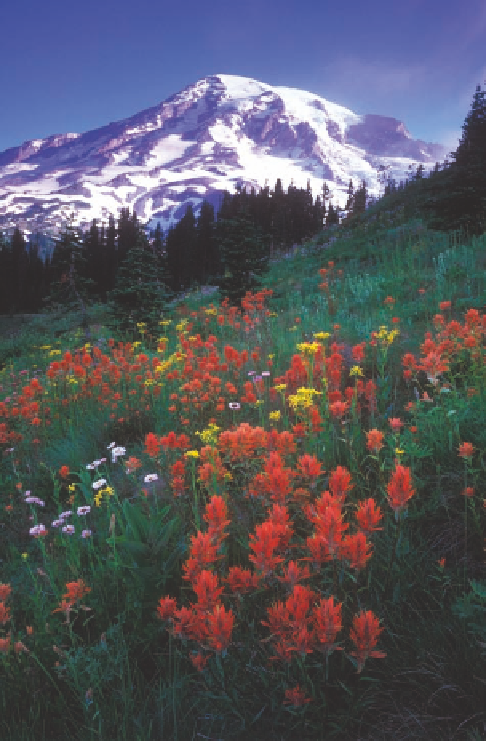Environmental Engineering Reference
In-Depth Information
Beneath the stands of trees is a deep layer of par-
tially decomposed conifer needles and leaf litter. De-
composition occurs slowly because of the low temper-
atures, waxy coating of conifer needles, and high soil
acidity. The decomposing conifer needles make the
thin, nutrient-poor soil acidic and prevent most other
plants (except certain shrubs) from growing on the for-
est floor.
These biomes contain a variety of wildlife. During
the brief summer the soil becomes waterlogged, form-
ing acidic bogs, or
muskegs,
in low-lying areas of these
forests. Warblers and other insect-eating birds feed on
hordes of flies, mosquitoes, and caterpillars that breed
in these habitats.
Coastal coniferous forests
or
temperate rain forests
are
found in scattered coastal temperate areas with ample
rainfall or moisture from dense ocean fogs. Dense
stands of large conifers such as Sitka spruce, Douglas
fir, and redwoods dominate undisturbed areas of bio-
mes along the coast of North America, from Canada to
northern California.
Figure 5-20 lists major human impacts on the
world's forests.
Some of the world's most spectacular environ-
ments are
mountains
(Figure 5-21), which cover about
one-fifth of the earth's land surface. Mountains are
places where dramatic changes in altitude, climate,
soil, and vegetation take place over a very short dis-
tance (Figure 5-9, left). Because of the steep slopes,
Figure 5-21
Natural capital degradation:
mountains such
these in Washington state's Mount Ranier National Park play
important ecological roles.
Natural Capital Degradation
Forests
mountain soils are especially prone to erosion when
the vegetation holding them in place is removed by
natural disturbances (such as landslides and
avalanches) or human activities (such as timber cut-
ting and agriculture). Many freestanding mountains
are
islands of biodiversity
surrounded by a sea of lower-
elevation landscapes transformed by human activities.
Mountains play a number of important ecological
roles. They contain the majority of the world's forests,
which are habitats for much of our planet's terrestrial
biodiversity. They often are habitats for endemic spe-
cies found nowhere else on earth, and they serve as
sanctuaries for animal species driven from lowland
areas.
They also help regulate the earth's climate. Moun-
taintops covered with ice and snow reflect solar radia-
tion back into space. Mountains affect sea levels as a
result of decreases or increases in glacial ice—most of
which is locked up in Antarctica (the most mountain-
ous of all continents).
Clearing and degradation of tropical
forests for agriculture, livestock
grazing, and timber harvesting
Clearing of temperate deciduous
forests in Europe, Asia, and North
America for timber, agriculture, and
urban development
Clearing of evergreen coniferous
forests in North America, Finland,
Sweden, Canada, Siberia, and Russia
Conversion of diverse forests to less
biodiverse tree plantations
Damage to soils from off-road vehicles
Figure 5-20
Natural capital degradation:
major human im-
pacts on the world's forests.
Critical thinking: what are the direct
and indirect effects of your lifestyle on forests.


